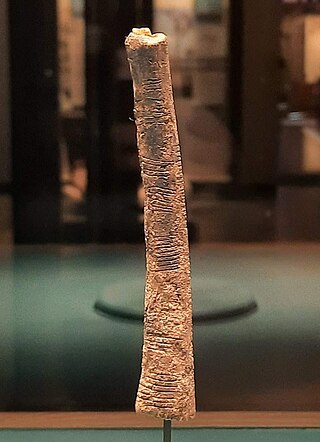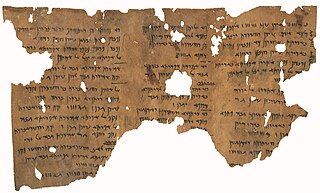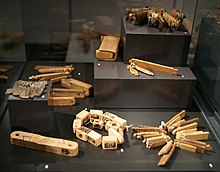
Hockey is a term used to denote a family of various types of both summer and winter team sports which originated on either an outdoor field, sheet of ice, or dry floor such as in a gymnasium. While these sports vary in specific rules, numbers of players, apparel, and playing surface, they share broad characteristics of two opposing teams using a stick to propel a ball or disk into a goal.
Tallage or talliage may have signified at first any tax, but became in England and France a land use or land tenure tax. Later in England it was further limited to assessments by the crown upon cities, boroughs, and royal domains. In effect, tallage was a land tax.
Stock is a representation of capital paid or invested into a business entity by stockholders.

In the civil service of the United Kingdom, His Majesty's Exchequer, or just the Exchequer, is the accounting process of central government and the government's current account in the Consolidated Fund. It can be found used in various financial documents including the latest departmental and agency annual accounts.

The Palace of Westminster, the medieval royal palace used as the home of the British parliament, was largely destroyed by fire on 16 October 1834. The blaze was caused by the burning of small wooden tally sticks which had been used as part of the accounting procedures of the Exchequer until 1826. The sticks were disposed of carelessly in the two furnaces under the House of Lords, which caused a chimney fire in the two flues that ran under the floor of the Lords' chamber and up through the walls.

Ice stock sport is a winter sport, somewhat similar to curling. In German, it is known as Eisstockschießen. Although the sport is traditionally played on an ice surface, events are also held on tarmac in summer.
Etruscan numerals are the words and phrases for numbers of the Etruscan language, and the numerical digits used to write them.
The King's Remembrancer is an ancient judicial post in the legal system of England and Wales. Since the Lord Chancellor no longer sits as a judge, the Remembrancer is the oldest judicial position in continual existence. The post was created in 1154 by King Henry II as the chief official in the Exchequer Court, whose purpose was "to put the Lord Treasurer and the Barons of Court in remembrance of such things as were to be called upon and dealt with for the benefit of the Crown", a primary duty being to keep records of the taxes, paid and unpaid.

The Ishango bone, discovered at the "Fisherman Settlement" of Ishango in the Democratic Republic of Congo, is a bone tool and possible mathematical device that dates to the Upper Paleolithic era. The curved bone is dark brown in color, about 10 centimeters in length, and features a sharp piece of quartz affixed to one end, perhaps for engraving. Because the bone has been narrowed, scraped, polished, and engraved to a certain extent, it is no longer possible to determine what animal the bone belonged to, although it is assumed to belong to a mammal.
Number systems have progressed from the use of fingers and tally marks, perhaps more than 40,000 years ago, to the use of sets of glyphs able to represent any conceivable number efficiently. The earliest known unambiguous notations for numbers emerged in Mesopotamia about 5000 or 6000 years ago.

A chirograph is a medieval document, which has been written in duplicate, triplicate or very occasionally quadruplicate on a single piece of parchment, with the Latin word chirographum written across the middle, and then cut through to separate the parts. The term also refers to a papal decree whose circulation is limited to the Roman curia.

An animal pound is a place where stray livestock were impounded. Animals were kept in a dedicated enclosure, until claimed by their owners, or sold to cover the costs of impounding.
The Exchequer of the Jews was a division of the Court of Exchequer at Westminster which recorded and regulated the taxes and the law-cases of the Jews in England and Wales. It operated from the late 1190s until the eventual expulsion of the Jews in 1290.

Taxation in medieval England was the system of raising money for royal and governmental expenses. During the Anglo-Saxon period, the main forms of taxation were land taxes, although custom duties and fees to mint coins were also imposed. The most important tax of the late Anglo-Saxon period was the geld, a land tax first regularly collected in 1012 to pay for mercenaries. After the Norman Conquest of England in 1066, the geld continued to be collected until 1162, but it was eventually replaced with taxes on personal property and income.

Shit stick means "a thin stake or stick used instead of toilet paper" for anal hygiene and was a historical item of material culture introduced through Chinese Buddhism and Japanese Buddhism. A well-known example is gānshǐjué/kanshiketsuwato from the Chan/Zen gōng'àn/kōan in which a monk asked "What is buddha?" and Master Yunmen/Unmon answered "A dry shit stick".
The Lebombo bone is a bone tool made of a baboon fibula with incised markings discovered in Border Cave in the Lebombo Mountains located between South Africa and Eswatini. Changes in the section of the notches indicate the use of different cutting edges, which the bone's discoverer, Peter Beaumont, views as evidence for their having been made, like other markings found all over the world, during participation in rituals.
National archives are the archives of a country. The concept evolved in various nations at the dawn of modernity based on the impact of nationalism upon bureaucratic processes of paperwork retention.

Tally marks, also called hash marks, are a form of numeral used for counting. They can be thought of as a unary numeral system.
Josh Wale is a British professional boxer. He held the British bantamweight title from 2017 to 2018. He challenged for the Commonwealth bantamweight title in 2012; the Commonwealth super bantamweight title in 2016; the European bantamweight title in 2018; and the British super bantamweight title three times between 2014 and 2019.

The Khalili Collection of Aramaic Documents is a private collection of letters and documents from the Bactria region in present-day Afghanistan, assembled by the British-Iranian collector and philanthropist Nasser D. Khalili. It is one of the Khalili Collections: eight collections of artifacts assembled, conserved, published and exhibited by Khalili.













